Science Book Gift Guide 2022
By The Editors
STEM-related books for any season
December 15, 2022
Science Culture Communications Review Scientists Nightstand
If you're still looking for holiday gifts, might we suggest some STEM books? They're not just for holiday gift giving, though; they make excellent presents at any time. To help you choose from all of the books on the market right now, we’ve briefly reviewed below some books for readers of all ages that we’ve enjoyed this year.
STEM Books for Young Readers
(Suggested age ranges, where noted, are those provided by the publisher.)
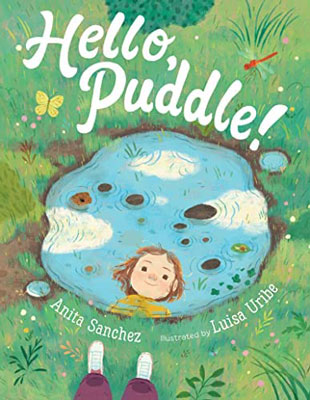
Hello, Puddle!, by Anita Sanchez. Illustrated by Luisa Uribe. Ages 4–7. Clarion Books, 2022. $17.99.
Hello, Puddle! celebrates the joy of noticing. I have yet to meet a child that isn’t interested in puddles and taking a look (or maybe dipping a toe) in the water. A whole world in microcosm awaits the little girl who regularly visits one puddle as it changes through the seasons. Lively illustrations by Luisa Uribe accompany the poetic descriptions of seasonal changes. Lots of animals visit the puddle, including birds, squirrels, and bugs—several animals even have babies there, from squiggly toad eggs to turtle hatchlings. Although the book is aimed at older early readers, my 21-month-old enjoys the elaborate pictures, pointing out all the different animals and naming them. I love that this book doesn’t get old quickly—there’s enough detail pictured on each page to spark new observations upon repeated readings. Maybe a young reader will be inspired to find a puddle of their own to visit and discover worlds within.
—Katie L. Burke
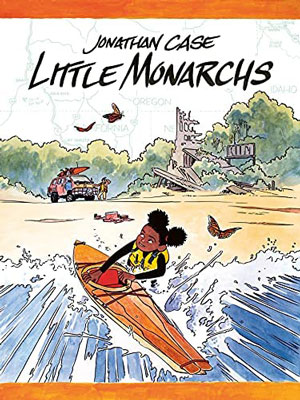
Little Monarchs, by Jonathan Case. Ages 8–12. Margaret Ferguson Books, 2022. $22.99.
Little Monarchs, a tween graphic novel, is about an alternate future of Earth where, due to pollution and global warming, the Sun has become deadly to all mammals, and if their skin gets exposed to it, they will die quickly. They call this Sun disease. Because people can’t survive, the few that are left now live underground in bases scattered across the world and only come out at night to get food; these people are called underdwellers. A girl named Elvie and her guardian Flora are able to be exposed to the Sun because Elvie’s parents and Flora figured out a treatment for the disease, and they are trying to make as much of it as they can. They figured out that the monarch butterfly’s scales, when you use a certain method, you only need a few to create enough of the treatment to fill a syringe and treat a person, but you have to do this every other day. They are trying their best to figure out how to make it permanent, and they are following the monarch’s migration to Mexico. While on their journey, they encounter many dangers, but eventually they are successful. The story has a great plot with unexpected twists, although it takes a bit to get going. The story has a helpful message to think about what could happen if nothing is done about global warming. The story seems to have a cliffhanger at the end, which I found frustrating. Overall, I would recommend it to kids ages 9–13 who like bugs.
—Theodora Reed (age 11, daughter of Fenella Saunders)
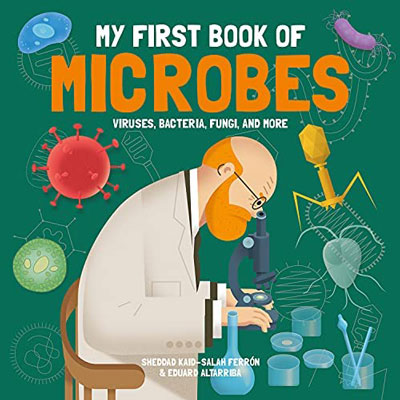
My First Book of Microbes, by Sheddad Kaid-Salah Ferrón. Illustrated by Eduard Altarriba. Ages 8 years and up. Button Books, 2022. $17.99.
The “My First Book of” series is a great way for science-curious kids to dive deeply into complex topics, and My First Book of Microbes is no exception. The book is densely packed with information that is detailed and comprehensive, yet clear—perfectly aimed at its target audience of older-elementary students. Each page is like an infographic, with text and art playing off one another to boost understanding. Author Sheddad Kaid-Salah Ferrón and illustrator Eduard Altarriba walk through the scientific study of microbes, including not only bacteria, viruses, and protozoa, but also the mechanics behind microscopy, the science behind vaccines, and the development of microbial biotechnology. Since this book was published in 2022, the last pages examine COVID-19 and the microbe that causes it, SARS-CoV-2. The book would make a great gift for any kid who is ready to start independently finding the answers to all of their pressing “whys” and “hows.”
—Stacey Lutkoski
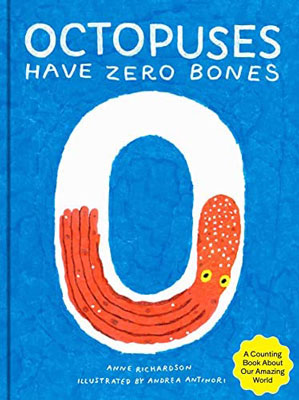
Octopuses Have Zero Bones, by Anne Richardson. Illustrated by Andrea Antinori. Ages 6–9 years. Tra Publishing, 2022. $19.99.
When Octopuses Have Zero Bones landed on my desk, I thought it would be a fun counting book for my kindergartner. The book starts simply enough, with the concept of zero, meaning nothing. But a few pages in, I realized that the book is so much more than I had expected. Rather than simply progressing from 0 to 10, author Anne Richardson jumps into the power that zero holds in base-10 counting, and how zeros can bring us from nothing to billions. For example, Richardson notes that humans have one heart, and that if you place a zero after the one, you get the number of fingers on your hands. We learn that there are five petaloids on a sand dollar, and that there are up to 500,000 (five with five zeroes) leaves on a mature oak tree; tardigrades have eight legs, and Saturn is about 800,000,000 (eight with eight zeroes) miles from Earth. As I read the book to my kindergartner, my third grader sidled over to listen too. The book has interesting facts for readers of all ages, and the exploration of base-10 counting aligns with how kids today are taught arithmetic. The content is accompanied by Andrea Antinori’s charming illustrations. His style encompasses both the somewhat-abstract concept of a jiggling cesium atom (oscillating at nine billion times per second—nine with nine zeroes) and the actual size of the largest raindrops (8 millimeters in diameter). The book makes for a great bedtime read, and it is also a beautiful, oversized book that you can leave on your coffee table to dip in and out of while you digest your holiday meal (which, according to the book, takes on average three days, so you’ll have plenty of time to read).
—Stacey Lutkoski

One Million Trees: A True Story, by Kristen Balouch. Ages 4–8 years. Margaret Ferguson Books, 2022. $18.99.
One Million Trees is a fun and educational picture book that tells the true story of author Kristen Balouch and her family, who left their home in California and moved to British Columbia to help replace trees cut down by loggers. With colorful and cheerful art and easy-to-follow main text, she writes about how her family and a crew chosen by the Canadian government managed to plant 1 million trees in 40 days. The publisher’s stated target age range is four to eight years, and the main text of the story will appeal to that demographic; however, the pages also feature little notes and details that will appeal to older readers. For example, Balouch includes math equations that break down how they managed to plant 1 million trees, as well as more detailed explanations about why the trees were cut down. An author’s note at the end provides more information about her family’s trip, why trees and forests are important, and what they give back to the ecosystem.
—Jaime Herndon
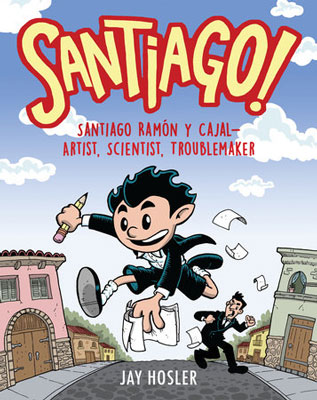
Santiago! Santiago Ramón y Cajal—Artist, Scientist, Troublemaker, by Jay Hosler. Ages 8–12. Margaret Ferguson Books/Holiday House, 2022. $22.99.
Santiago!, a graphic novel about the neuroscientist Santiago Ramón y Cajal, starts out with him as a child running away from his angry father, a theme that is repeated throughout his childhood. This biography of his life in comic book form shows how he really enjoyed art as a child, but his father doesn’t like art because he thinks it will leave him poor. His father wants him to be a doctor, but he doesn't want to be one. He does art anyway, and makes a lot of trouble in the process. He finds cool ways to make paint from everyday materials, and makes intricate weapons out of sticks and stones. He even went to juvenile prison for blowing up a gate with a cannon he made himself! In school, he was good in geography because he could draw maps well, but he failed out. His dad was angry and made him an apprentice to a cobbler making shoes, where he had to stay in an attic and fix a bunch of old, dirty shoes. He got really good at it and at craftsmanship in general, and his father was actually impressed by this progress. After that, Santiago started doing well in his classes and discovered he could easily work through science and logic problems. His artwork also won a prize. After drawing a caricature of one of his teachers, he got kicked out of school again. His father took matters into his own hands and decided personally to teach Santiago anatomy. Santiago learned this topic really well because he could draw well, and his dad was again
impressed by his work. Santiago became focused on the brain because the neurons connected in an intricate patterns. That put him on the path to succeeding in medical school and becoming a neuroscientist, famous for drawing neurons. I thought this book was really interesting and I would recommend it to other kids interested in science or biographies.
—Theodora Reed (age 11, daughter of Fenella Saunders)
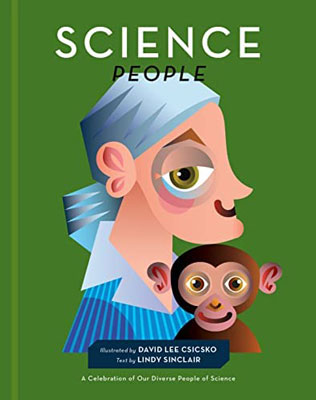
Science People: A Celebration of Our Diverse People of Science, by David Lee Csicsko and Lindy Sinclair. Trope Publishing, 2022. $24.99
Although there have been other books for kids that feature short biographies of scientists across cultures, David Lee Csicsko’s bold graphics make Science People a notable addition to those ranks. The vignettes of 50 “science people” feature a colorful caricature, quick facts, and a single page of text that is a good level for younger readers. The length of each biography means that the information is kept at a basic level, although there are a few facts sprinkled in that might be distressing for very young readers—such as that Hypatia was killed for her teaching—and that might require some contextualizing discussion. The entries are in chronological order, from ancient to modern times, and feature well-known names such as Albert Einstein and Bill Nye, but also lesser-known scientists, such as biochemist Michiyo Tsujimura (1888–1969) and botanist Janaki Ammal (1897–1984). It also features currently living scientists, such as bat researcher Phillip Alviola and microbiologist Monkgomotsi Maseng. All in all, it’s a great volume for curious budding scientists.
—Fenella Saunders
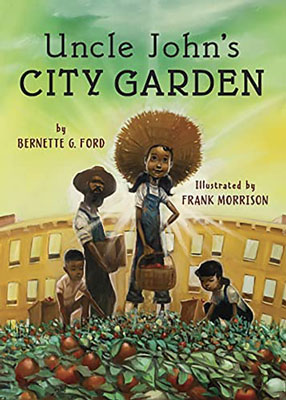
Uncle John's City Garden, by Bernette G. Ford. Illustrated by Frank Morrison. Ages 4–8. Holiday House, 2022. $18.99.
L'il Sissy and her brother and sister spend the summer visiting their Uncle John’s garden, each choosing one or two favorite vegetables to tend: corn, lima beans, tomatoes, onions, and okra. When they tell their mother, she laughs and says they’re “growing succotash.” The children grow their plants under their uncle’s guidance, digging, watering, and weeding. They celebrate their harvest with a barbecue, complete with succotash, and then everyone goes home with some extra produce. L'il Sissy is a particularly observant narrator, comparing sizes of plants, produce, and garden tools. Bernette G. Ford, the first African American vice president of children’s books at a major publisher and author of No More Diapers for Ducky and co-author of the 1990 bestseller Bright Eyes, Brown Skin, writes this semi-autobiographical story, based on her uncle’s garden in the 1950s in Brooklyn, New York. Illustrations by Frank Morrison highlight how the garden brings the family together, with golden light and soft brush strokes that invoke good memories. The last page includes a recipe for succotash, so that young readers, too, can try (with adult supervision) cooking up the meal with locally grown produce.
—Katie L. Burke
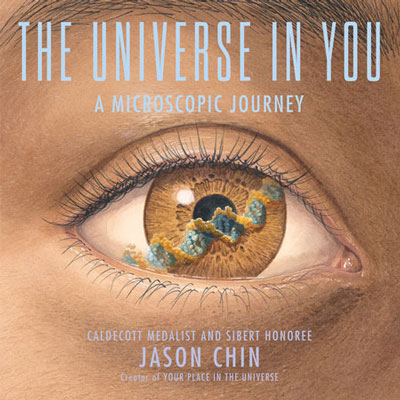
The Universe in You: A Microscopic Journey, by Jason Chin. Ages 8–12 years. Neal Porter Books/Holiday House, 2022. $18.99.
If you’ve ever read a picture book by Jason Chin, you know not to make assumptions about them being only for young kids. He’s written about the Grand Canyon, gravity, redwoods, and the Galapagos, and in The Universe in You, he turns inward: toward cells and other tiny entities. He explores the parts of a cell, DNA, atoms, and elementary particles, and then relates the smallest things to the larger universe. The explanations are descriptive without being either overly simplistic or complicated, and in the back of the book there is additional information about matter, molecules, cells, DNA, and more. This book is a delight to read and get lost in, and it’s one that you want to sit with and savor. The intricate and beautiful illustrations draw kids in and pique their interest in the story. This book is one you’ll keep on the shelves long after your kids have moved on from picture books.
—Jaime Herndon
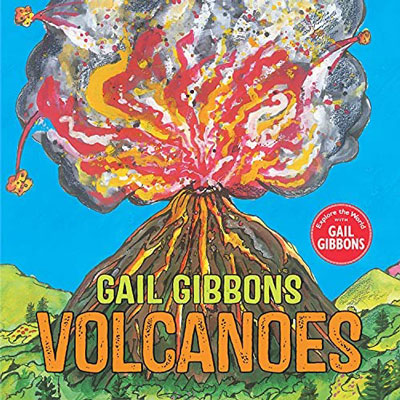
Volcanoes, by Gail Gibbons. Ages 4–8 years. Holiday House, 2022. $18.99.
Gail Gibbons is known for her beautifully illustrated, fact-filled science picture books for young children, and Volcanoes is a great addition to her collection. Fully vetted by a volcanologist, this book is jam-packed with information about layers of the earth, tectonic plates, types of volcanoes, who studies volcanoes and what they do, what happens when a volcano erupts, and much more. There’s also a summary of volcano facts, and what to do in case you’re in the vicinity of a volcano warning. Although the age range says 4–8 years, this book would be an engaging, visually appealing resource for kids of all ages (and adults, too!).
—Jaime Herndon
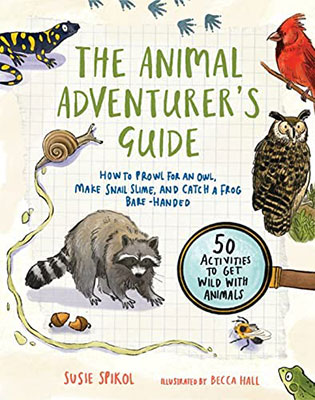
The Animal Adventurer’s Guide: How to Prowl for an Owl, Make Snail Slime, and Catch a Frog Bare-Handed – 50 Activities to Get Wild With Animals by Susie Spikol, illustrated by Becca Hall. Roost Books, 2022. $17.95
As a parent, I tend to approach books about animals aimed at children and teens with a vague sense of dread. Will this one be simplistic and silly? Tediously academic and dry? Full of fun-sucking admonitions to “ask your Mom or Dad for help”? Or perhaps the most tiresome cliché of all, it's packed with scatological jokes and gross-out details designed to prove, Hey, young people, the animal world can be really cool!
Thankfully, The Animal Adventurer’s Guide is none of those things. Susie Spikol writes with the wide-eyed enthusiasm of someone who developed her love of wildlife early and never lost it. (She is currently a nature writer and a naturalist at the Harris Center for Conservation Education in New Hampshire.) Equally refreshing, her recommended animal adventures require nothing more than ordinary household items, a vibrant sense of curiosity, and access to a back yard, a sidewalk, or a local park. That tracks with her biography, too: Spikol grew up in Brooklyn, where you have to shift your perspective to recognize the wildlife all around you.
The book is divided into five sections, covering birds, mammals, herps (a.k.a., amphibians and reptiles), arthropods, and other invertebrates. The 50 suggested animal adventures are all implicitly built around the fundamentals of the scientific method: asking questions, proposing answers, observing nature, and recording the most interesting details. Even when the adventures seem simple, there’s usually a twist. In an entry about frog-catching, for instance, Spikol adds unfamiliar, step-by-step techniques needed for success. In another entry about bird calls, she reveals a secret pshsst sound that will make chickadees and nuthatches respond. And there are a few genuine surprises, like the instructions to create a homemade insect vacuum (aka a “bug pooter”) to pull wild specimens into a jar without harming them.
If The Animal Adventurer’s Guide has a weakness, it's that sometimes the author's approach is too minimalist. Spikol endorses old-school pencil-written notes in a journal, but most of her young readers would probably find it more natural and equally effective to take notes on their smartphones. She also limits her mentions of online resources to a brief section at the end, even though some modern apps (like Cornell’s Merlin Bird ID, which can recognize hundreds of bird calls) can enhance, rather than distract from, the discovery process.
Still, Spikol’s minimalist approach has its definite charms. She recognizes that many kids may not have access to true binoculars, so she explains up front how to make “tube binoculars” using tape and a pair of toilet paper rolls. It’s not only a cost-saving trick: it’s also a reminder that the single most important tool for exploring wildlife is intense, focused attention.
—Corey S. Powell

My Mechanical Romance, by Alexene Farol Follmuth. Ages 13+. Holiday House, 2022. $18.99.
This is not your typical YA romcom. My Mechanical Romance is a delightfully nerdy, empowering book about a young woman of color and the barriers she faces in the STEM world at the most basic levels—as well as the heart-pounding experience of teenage first love. Bel doesn’t want to think about the future or college, but when she shows talent in engineering, she gets pulled in to the robotics club. There she meets Mateo, the captain: He sees her talents, and she makes him think—but when they start disagreeing, Bel wonders whether STEM is really open to fiery, opinionated girls like her. Alexene Farol Follmuth really looks at the experience of girls of color in STEM, the challenges they face from an early age, and much more. I liked that she wrote about tough topics such as privilege and financial stress that come with things like choosing a college, and vividly portrayed the uphill battle for young women, especially young women of color, in STEM.
—Jaime Herndon
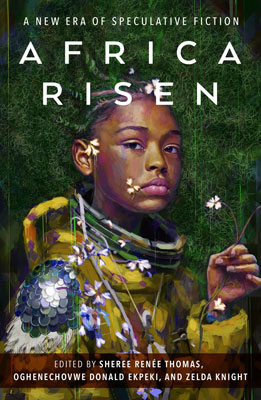
Africa Risen: A New Era of Speculative Fiction, edited by Sheree Renée Thomas, Oghenechovwe Donald Ekpeki, and Zelda Knight. Tor Publishing Group, 2022. $27.99
I don’t always go for short story collections…but when I do, I go for science-fiction and fantasy and speculative fiction ones—and Africa Risen is definitely one to check out this holiday season. Perfect for anyone YA and older, this collection of speculative fiction from Africa and the African diaspora has 32 writers sharing stories of horror, fantasy, and sci-fi, including Tananarive Due, Chinelo Onwualu, and Alex Jennings. There are stories about a dying planet and conservation, stories rooted in African folklore and mythology, magic, witches, family, and so much more that it’s hard to describe all of them. This is a book you want to read slowly, to savor each story and the world the author creates, to absorb the lush prose and intricate details. The worldbuilding is immersive and transporting, a welcome addition to any science-fiction/fantasy reader’s bookshelf.
—Jaime Herndon

Atlas of Perfumed Botany, by Jean-Claude Ellena and translated by Erik Butler. The MIT Press, 2022. $29.95.
This gorgeous guide to aromatic plants distills Jean-Claude Ellena’s 50-plus years in the perfume industry, organized in categories based on the part of the plant from which scents are extracted (leaves, flowers, roots, and so on). This organization emphasizes how the exact part used can change the tenor of the scent. What I especially like about this book—and what sets it apart—is the author’s bits of memoir throughout. Ellena strikes a quirky yet poetic tone as he recounts “the affective connection” he has with each plant through the lens of his fascinating professional life, starting out in an essential oil factory and eventually designing perfumes for Hermès and Le Couvant. There’s plenty of organic chemistry and plant biology for the scientifically inclined, as well. Ellena writes about how new extractions changed what plants were in use, and he does not shy away from amicable discussions of hexane or phenethyl alcohol (the former used in extraction and the latter an isolated molecule of rose’s scent). “There are hundreds of products of natural origin, but thousands of chemical compounds,” Ellena writes. “From the convergence of products of both natural and chemical origin, the art of perfume is born.” In reading Ellena’s Atlas of Perfumed Botany, I learned much about plants whose scents I wasn’t even aware of: the lichen called oakmoss (Evernia prunastri), once used as a preservative and “for base notes” in fragrances, and later abandoned because of its “allergenic potential;” galbanum gum (Ferula gummosa) from the arid mountains of Iran, used in midcentury French perfumes as “the odor of happiness;” or the snail-shell-shaped ambrette seeds (Hibiscus abelmoschus) of Ecuador, which when ground up smell of “musk, pear, and iris” and are used to evoke the scent of pear brandy. Familiar plants that are essential in the fragrance business also are given their due: for example, vanilla, orange and neroli, rose, and lavender. I love the colorful illustrations by Karin Doering-Froger, which bring to mind vibrant (though rectangular) mandalas and show not only the plants under discussion, but also related animals, places, or perfume bottles. Easy to dip into as a reference or for a reading dabble with a spot of tea, this book’s offering of a little history and memoir, a little geography, and a little chemistry and botany will offer most readers something of interest as they peruse.
—Katie L. Burke
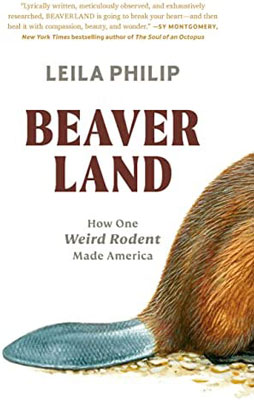
Beaverland: How One Weird Rodent Made America, by Leila Philip. Twelve Books, 2022. $30.00.
If you’re like most people, you probably don’t really think about beavers that much. Or really, at all. Leila Philip, on the other hand, thinks about them a lot, and has written an entire book on this rodent and how it’s influenced our country. In Beaverland, she not only explores the history of the accomplishments and contributions of beavers throughout America’s history, but she also takes the reader into the fur trade and the world of “beaver believers,” a fascinating group of activists. We’re introduced to Indigenous environmentalists, PETA activists, scientists, and many more people who study beavers, conservation, and the role the animals play in conservation. One thing is for sure: You’ll never look at beavers the same way after reading this book.
—Jaime Herndon
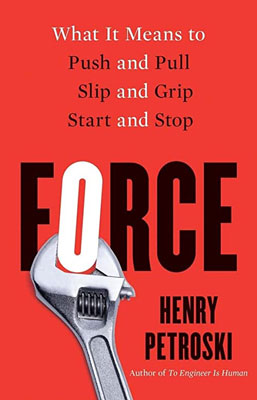
Force: What It Means to Push and Pull, Slip and Grip, Start and Stop, by Henry Petroski. Yale University Press, 2022. $30.00.
Taking an engineer’s viewpoint to basic physical forces, Henry Petroski examines the complex interplay of pushes and pulls that go into everyday acts—for example, there are at least three or four different forces at play in just putting on a pair of pants, he notes. In Force, he brings to the fore these slips and grips that we take for granted and barely notice, in chapters that focus on gravitation, magnetism, and friction, and he details where these forces actually originate. He examines the destructiveness of shaking and sliding forces, the power of cantilevers in many places we don’t even see in amplifying simple forces, and the role of inertia in moving things around. He moves on to cover stretching and squeezing in springs and packaging, deployable structures that unfold or change when forces are added or removed, and even how forces can be modeled in living organisms. His delightful treatise on these basics of physics that we inherently use without thinking will give readers a new appreciation of the complexity of themselves and the world around them.
—Fenella Saunders
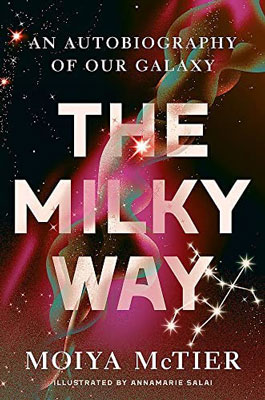
The Milky Way: An Autobiography of Our Galaxy, by Moiya McTier. Grand Central Publishing, 2022. $27.00.
Moiya McTier, a science communicator who is also an astrophysicist and folklorist, has written a book about the galaxy that defies genre. The Milky Way is the story of the galaxy, told by the galaxy—and who knew the galaxy was so witty? In this book, the galaxy explains its origins, makes observations about our own scientific explorations and bumblings, and ruminates on how its existence might end. McTier doesn’t shy away from complex explanations or content, but she does it in an entertaining way that keeps you reading.
—Jaime Herndon
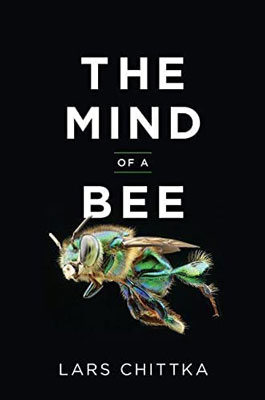
The Mind of a Bee, by Lars Chittka. Princeton University Press, 2022. $29.95.
In the main library at Oberlin College hangs a quilt that depicts landmarks and events from the school’s history. One square is a favorite of many students, including me. It features a beehive and motto from 1834: “Drones cannot be tolerated in this hive of industry.” We all loved this more-metal version of the school’s official motto, Learning and Labor. I trace my love of bees back to that quilt.
The Mind of a Bee challenges the idea of unthinking drones or workers. Sensory and behavioral ecologist Lars Chittka states in the introduction that his goal is to convince readers that although bees do operate in part based on instinct, they also make decisions based on knowledge, memories, an understanding of outcomes, and even personality. He writes, “Insect societies may look to us like smoothly oiled machines in which the individual plays the part of a mindless cog, but a superficial alien observer might come to the same conclusion about human society.” The book then walks through how bees sense the world, how they communicate, navigate, and cooperate, and how their brains work. By the end of the book, it becomes clear that a hive of industry should not only tolerate, but welcome and nurture bees of all types, including drones.
—Stacey Lutkoski
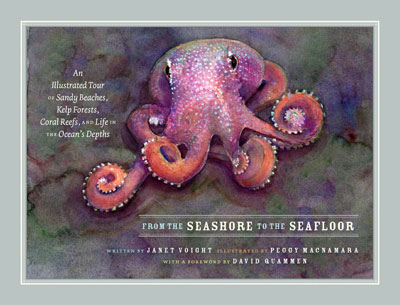
From the Seashore to the Seafloor: An Illustrated Tour of Sandy Beaches, Kelp Forests, Coral Reefs, and Life in the Ocean’s Depths, by Janet Voight and Peggy Macnamara. The University of Chicago Press, 2022. $25.00.
A bright, magenta warty octopus rendered in watercolor on the cover made me pick up this book and skip directly to the artist’s introduction. From the Seashore to the Seafloor, a tiny coffee table book, is a marvelous collaboration by author and deep-sea biologist Janet Voight and Field Museum artist-in-residence Peggy Macnamara. Together, they take you on a grand tour of the beaches, intertidal waters, and deep seas of the East Pacific Ocean, the Indo-West Pacific, and the Gulf of Mexico, all of which are teeming with life. Voight’s descriptions of the animals that inhabit these wildly varying environments and the rigors of ocean “fieldwork” are fascinating. Macnamara’s illustrations throughout the book vividly bring these creatures to life, and her notes and insights on painting techniques are interesting and inspiring. She says that the habit of observation “leads to discovery in both art and science.” Anyone who loves and wants to protect and conserve our planet’s beaches, oceans, and abundant sea life would be thrilled to have this little gift of a book.
—Barbara Aulicino

Seeing with Fresh Eyes: Meaning, Space, Data, Truth by Edward Tufte. Graphics Press, 2022. $40.00
Beginning with his first book, Visual Explanations, Edward Tufte has explored the intricate processes whereby information that we take in through our eyes is transformed into ideas and emotions in our minds. His fifth volume, the aptly titled Seeing with Fresh Eyes, continues this tradition, browsing among fields that range from medical charts to Egyptian hieroglyphics to violinist Yehudi Menuhin’s annotations of a Bach sonata. Along the way, the author provides abundant examples of both successful and unsuccessful graphic design, explaining what makes some of them enlightening, whereas others are merely confusing. When it comes to design, Tufte practices what he preaches: from the typography to the strategic use of space to the delicate coloring of the illustrations, the book is a visual delight.
From an introduction titled “The Thinking Eye,” to chapters on meaning and space, data analysis when truth matters, instructions at point of need, the theory and practice of lists, and remodeling the back-matter in books, Tufte shows how clear thinking and clear presentation are inextricably linked, each enabling the other. If you’re planning to give a copy of this book to a favorite artist or designer in your life, be sure to keep a copy for yourself as well—your eyes and your mind will thank you.
—Sandra J. Ackerman
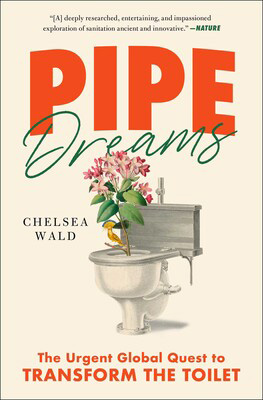
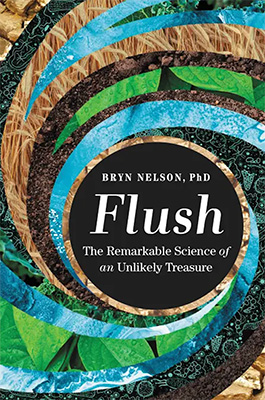
Pipe Dreams: The Urgent Global Quest to Transform the Toilet by Chelsea Wald, Simon & Schuster, 2022. $18.99.
Flush: The Remarkable Science of an Unlikely Treasure by Bryn Nelson, PhD., Grand Central Publishing, 2022. $30.
We can only imagine what our ancestors thought when they discovered the value of the—ahem!—products of their own digestion. From fertilizer to teeth whitening, tanning animal skins to making medicines and gunpowder, people have found all kinds of uses for these excretions, including catapulting it at their enemies during war.
Our disgust toward feces and urine is understandably strong. Evolutionary psychologists presume that our response evolved because of the selective pressure (death!) from messing around with it. None of that keeps people from discussing it, however: Parents of newborns talk colors; kids and comedians tell jokes; patients and health-care workers discuss flow and production. Historians have even correlated past civilizations and whether they thrived or died, based on their mastery in dealing with it.
In their respective books, award-winning science journalists Chelsea Wald and Bryn Nelson focus on our civilization’s urgent need to deal with our bodily excretions better. Their books are complementary to one another, completing an up-to-date triptych of the topic along with Lina Zeldovich’s The Other Dark Matter (2021, mentioned in last year’s gift guide). (Editor’s note: find Christopher Hamlin’s 2009 review ,“Deep Doo Doo,” of an older triptych of books on the same topic.)
In Pipe Dreams, Wald focuses on the scientists, engineers, activists, philanthropists, and entrepreneurs who are turning those dreams into reality: making toilets safer, more accessible, and more useful to humanity, with special attention to sustainability. Weaving together extensive research along with her own experiences, Wald takes readers around the world, including to a rarely accessible Ancient Roman lavatory (complete with graffiti), shadowing an Indonesian salesman who travels to people’s homes to pitch septic tanks, and to the Netherlands and her own tale of discreetly donating urine to a group that collects it to extract fertility hormones. To Wald, the term human waste is inappropriate, denying the inherent value of it.
In Flush, Nelson examines the value of our excrement, starting with how we make it: Nelson begins with the digestion process of a cheeseburger. Building on the understanding that input affects output, Nelson, who trained as a microbiologist, explains how our output also depends on the communities of bacteria—our microbiome or gastrointestinal fauna—and how they differ, based on our diets. For example, people with fiber-rich diets produce much heavier stools; using antibiotics can cause gastrointestinal distress; and fecal microbial transplants are sometimes used to treat people with microbiomes that are making them sick. Nelson’s other main line of inquiry is the chemistry (including DNA) in excrement, including how it has helped people solve crimes, better understand historical mysteries, and treat and make use of sewage, along with explanations about why using processed sewage remains controversial.
Both authors write with wit and humor, and I found myself regularly laughing at the many stories and groaning at the many puns, including in how they characterize themselves: Wald has earned the nickname “Queen of Loo-topia,” and Nelson refers to himself in dedicating his book to his parents as “your #2 son.” Full disclosure: I know both authors; Nelson and I are part of the SciLance community named in the book’s credits, and we each contributed a chapter to The Science Writers’ Handbook (2013, Da Capo). But given all of our respective outgoing natures, we would have had to actively ignore one another not to meet at the many science meetings over the years. Both these authors are leaders, and here’s the bottom line: In different ways, each of their books help readers make the mental shift to start giving a crap about crap.
—Robert Frederick
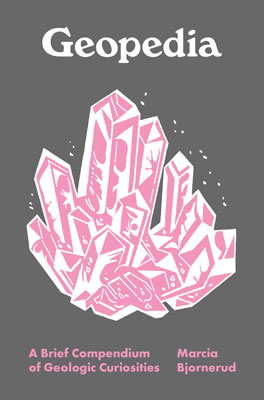
Geopedia: A Brief Compendium of Geologic Curiosities by Marcia Bjornerud. Princeton University Press, 2022. $16.95.
Astronomers are fond of reminding people that we are all made of stardust, drawing on the evocative language of Carl Sagan. Geologists have always suffered from a poetry deficit by comparison, but Marcia Bjornerud attempts to right the balance with Geopedia. Bjornerud, a professor of geosciences at Lawrence University in Wisconsin, opens her book by noting that people are, more specifically, composed of water and minerals dissolved from rock. “You are literally made of Earth,” she writes.
From there, the author introduces the reader to 74 of her favorite bits of our planet—our extended family, in a sense—arranged alphabetically from “Acasta gneiss” to “zircon.” Each entry is presented as a geologic short story, typically one to three pages, evocatively linked both to the planet and to the creatures who live on it. When writing about zircons, for instance, Bjornerud describes “the most remarkable zircon biography yet discovered”: A crystal from the Moon rocks collected during the Apollo 14 mission that likely originated on Earth. The zircon was part of a rock that was flung into space by an enormous asteroid impact, only to be brought back home by resourceful astronauts billions of years later.
Most of the Geopedia entries focus on specific minerals or geologic formations, as one might expect, but the exceptions add another layer of delight to the book. In one section, Bjornerud talks about the “Deborah number,” a scientific unit that indicates whether a material behaves as a liquid or as a solid over some given interval—a timescale that could be months, but could just as easily be millions of years. In another, she discusses the fossilized remains of Tiktaalik, a transitional fossil from the time when animals were first beginning to move from water onto dry land. Tiktaalik’s remains were discovered among 375-million-year-old strata on Ellesmere Island, Canada, a moment of life’s history preserved in stone.
As befits its topic, Geopedia looks small and innocuous from the outside. But crack it open and—wow—you may be amazed by what you find within.
—Corey S. Powell
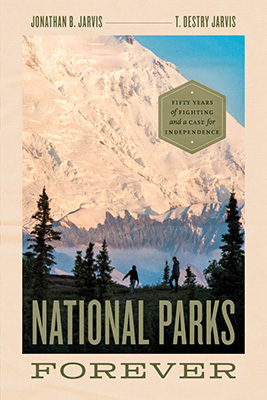
National Parks Forever by Jonathan Jarvis and T. Destry Jarvis, University of Chicago Press, 2022. $25.00.
Brothers Jonathan Jarvis and T. Destry Jarvis, the authors of National Parks Forever, understand the mission of the National Park Service (NPS) as specified by 1916 Organic Act that established the organization: to “provide for the enjoyment of the [parks, monuments, and reservations] in such manner and by such means as will leave them unimpaired for the enjoyment of future generations.”
Jonathan Jarvis served in the parks themselves, first as a park technician in 1976, and then joining the NPS as a park ranger. He advanced all the way to director of the NPS, a role in which he served from 2009 to January 3, 2017. After military service in Vietnam, Destry’s conservation efforts began as a volunteer lobbyist for Friends of Animals, spurred to action after learning how baby Arctic seals were clubbed to death for their pure white furs. He went on to serve in leadership roles for several conservation organizations involved with lobbying and political work on park issues.
In this self-described “dual memoir,” Jonathan and Destry take turns making the case—and then synthesize their viewpoints—that the NPS needs to be independent from the political “whipsaw” of Washington politics, making it more like the Smithsonian Institution.
It is a powerful and apt metaphor: On the one handle of the two-person saw, Republicans (starting with President Nixon) have pushed/pulled the whipsaw to deprofessionalize the NPS, appoint political leaders, add layers of decision-making bureaucracy, emphasize resource-extraction, and memorialize Republican presidents. On the other handle of the saw, Democrats have pulled/pushed for science-based conservation strategies that respect Indigenous knowledge, but without sufficient funding to do the job.
Former President Donald Trump’s actions cut the deepest: For the first time in the NPS’s history, there was no director, only “acting directors,” whom Trump could easily dismiss; every senior-level employee was moved, prompting many to retire; and political appointees directed NPS to take down websites mentioning climate change, to remove interpretive exhibits, and to prohibit park superintendents from talking to the media about extractive industry, among many other things.
The brothers’ perspectives are informed by an encyclopedic knowledge of the NPS and the broader ecosystem of conservation organizations. Their passion for the subject is conveyed throughout, most delightfully by thanking their wives and families for space and time at family gatherings to go off on their own to discuss the latest threats to the national parks.
This is not the first time the argument has been made in book form to make the NPS independent of party politics. It’s likely not the last, either. By providing both historical and personal context to the NPS’s politicization, the Jarvis brothers make a powerful case, albeit one that will strike some readers as politically partisan.
—Robert Frederick
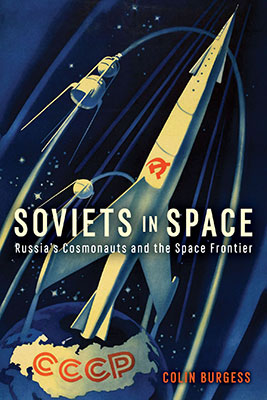
Soviets in Space: Russia’s Cosmonauts and the Space Frontier by Colin Burgess. Reaktion Books, distributed by The University of Chicago Press, 2022. $35.00.
The first Russian space travelers were a ragtag gang, “born into a life of seclusion and desperation on the back streets of Moscow…yet they one day would become known and lauded throughout the Soviet Union and even around the world.” That is how Colin Burgess, a longtime writer on military and space history, describes the stray dogs that Soviet engineers abducted, strapped into their rockets, and launched above Earth’s atmosphere, initiating the Space Race and the new era of exploration that followed from it.
It’s a cheeky bit of misdirection, but Burgess’s description of the mongrel rocketeers captures the spirit of the early Russian space program. While still reeling from its losses in World War II, the Soviet Union made rapid progress in aerospace technology. Its early successes—most notably the launch of the Sputnik satellite in October 1957 and Laika, the first dog in orbit, a month later—prompted astonished and terrified headlines across the West. Yet decades later, many of the stories behind those triumphs remain largely unknown, obscured by a decades of Cold War secrecy and competing American propaganda narratives. Burgess attempts to correct this with Soviets in Space, providing a succinct yet thorough account of the nation’s space program from early post-war experiments using captured Nazi V-2 rockets to the demise of USSR in 1991.
Soviet authorities were so guarded that they even hid the identity of their space program’s lead architect, Sergei Korolev, until after his death in 1967. A similar mood of secrecy and pathos hangs over much of the history of the Soviet Union’s space efforts. For years, the official line was that Laika, the first dog in orbit, died peacefully after circling the Earth for a week. In reality, Burgess notes, she suffered fatal heat prostration within the first seven hours of flight. One of the USSR’s most notable early space successes was kept so quiet, it is still unknown to all but the most avid trivia buffs. Six years before Laika, the Soviets launched two dogs, Tsygan and Dezik, on a suborbital flight, making them the first animals to return alive from space (not counting a few disoriented American fruit flies). No happy ending here, either: One week later, Dezik went up on a follow-up flight and died on impact when the capsule’s parachute failed to open.
Burgess mostly adopts a just-the-facts writing style (the story of the stray dogs notwithstanding), meaning that this book will probably be most enjoyed by a reader who is already interested in space history. But his straightforward approach is appropriate for the tragic characters and events of the Soviet space program; they do not need embellishment or editorializing. Time and again, limited resources and bureaucratic fumbling undermined the grandiose dreams of the scientists and engineers, especially after the death of the brilliant Korolev. Russia’s mighty N-1 Moon rocket exploded on the launch pad 13 days before NASA’s Saturn V got the job done for Apollo 11. The last new launch vehicle of the Soviet era, the Buran space shuttle, flew exactly once before being abandoned following the breakup of the USSR. Buran was mothballed in a hangar in Kazakhstan, and destroyed in 2002 when the hangar’s roof collapsed after a heavy rain.
To anyone who came of age after the 1970s, it’s hard to recall how innovative and forward-thinking the Russian space program once was. In 1963, cosmonaut Valentina Tereshkova became the first woman in orbit, a full two decades before the United States followed and broke up the all-male astronaut club. Today, Tereshkova is a staunch ally of Vladimir Putin in the Russian Duma, blocked by the U.S. State Department for her outspoken support of the war against Ukraine. Soviets in Space is not just a sharp chronicle of the nation’s early glories. It is also a cautionary tale of how the forces of nationalism and geopolitical competition that once propelled the Space Race to dizzying heights can also drive nations to decline and destruction.
—Corey S. Powell
American Scientist Comments and Discussion
To discuss our articles or comment on them, please share them and tag American Scientist on social media platforms. Here are links to our profiles on Twitter, Facebook, and LinkedIn.
If we re-share your post, we will moderate comments/discussion following our comments policy.